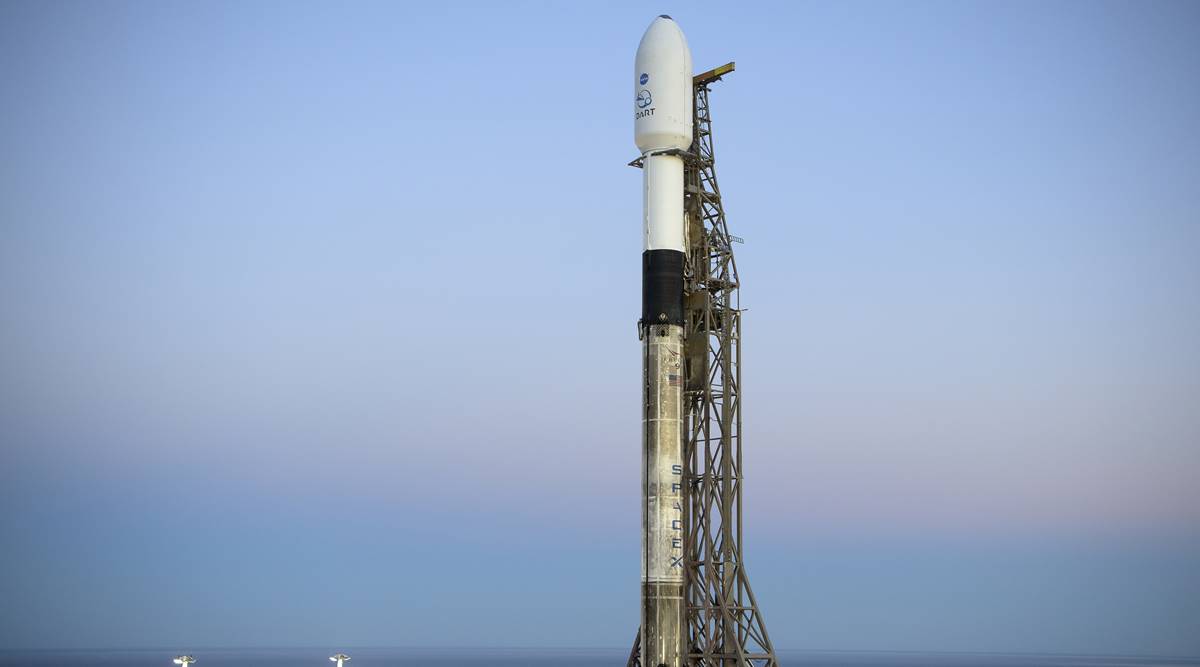 In an image provided by NASA, a SpaceX Falcon 9 rocket with the Double Asteroid Redirection Test, or DART, spacecraft onboard at the Space Launch Complex at Vandenberg Space Force Base in California, Tuesday, Nov. 23, 2021. (Bill Ingalls/NASA via The New York Times)
In an image provided by NASA, a SpaceX Falcon 9 rocket with the Double Asteroid Redirection Test, or DART, spacecraft onboard at the Space Launch Complex at Vandenberg Space Force Base in California, Tuesday, Nov. 23, 2021. (Bill Ingalls/NASA via The New York Times) Written by Joey Roulette
NASA is about to launch a spacecraft with one simple mission: Smash into an asteroid at 15,000 mph.
The mission, the Double Asteroid Redirection Test, or DART, leaves Earth early Wednesday to test whether slamming a spacecraft into an asteroid can nudge it into a different trajectory. Results from the test, if successful, will come in handy if NASA and other space agencies ever need to deflect an asteroid to save Earth and avert a catastrophic impact.
COMING UP: #DARTMission launch! 🚀
Our first test of #PlanetaryDefense is set to lift off at 1:21am ET (06:21 UTC) to attempt to change the motion of a non-threatening asteroid. Tune in at 12:30am ET (05:30 UTC) for live coverage: https://t.co/z1RgZwQkWS pic.twitter.com/qiOjrLLquM
— NASA (@NASA) November 24, 2021
When is the launch and how can I watch it?
The DART spacecraft is scheduled to lift off atop a SpaceX Falcon 9 rocket Wednesday at 1:20 am Eastern time from the Vandenberg Space Force Base in California.
NASA plans to host a livestream of the launch on its YouTube channel starting at 12:30 am Wednesday.
If bad weather around the Vandenberg launch site prompts a delay, the next opportunity for liftoff would be about 24 hours later.
Why is NASA crashing into an asteroid?
NASA is crashing DART into an asteroid to test, for the first time, a method of planetary defense that could one day save a city, or maybe the whole planet, from a catastrophic asteroid impact.
DART “is something of a replay of Bruce Willis’ movie, ‘Armageddon,’ although that was totally fictional,” Bill Nelson, NASA’s administrator, said in an interview.
The @SpaceX Falcon 9 carrying the DART spacecraft is vertical on the launch pad at @SLDelta30 in California! Launch is scheduled for Nov. 24 at 1:21am ET (Nov. 23 at 10:21pm PT) #DARTMission #PlanetaryDefense More 📷: https://t.co/iU5MOJDHCI pic.twitter.com/Ik7YhHa0be
— NASA HQ PHOTO (@nasahqphoto) November 23, 2021
If all goes as planned with DART, NASA will have a confirmed weapon in its planetary defense arsenal. Should a different asteroid ever wind up on a collision course with Earth, the world’s space agencies would have confidence that an asteroid missile like DART would shoo the space rock away.
How will the mission work?
After launching to space, the spacecraft will make nearly one full orbit around the sun before it crosses paths with Dimorphos, a football-field-sized asteroid that closely orbits a bigger asteroid, called Didymos, every 11 hours and 55 minutes. Astronomers call those two asteroids a binary system, where one is a mini-moon to the other. Together, the two asteroids make one full orbit around the sun every two years.
 Infographic showing the effect of DART’s impact on the orbit of Dimorphos.
Infographic showing the effect of DART’s impact on the orbit of Dimorphos.Credit: NASA/Johns Hopkins APL
poses no threat to Earth, and the mission is essentially target practice. DART’s impact will happen in late September or early October next year, when the binary asteroids are at their closest point to Earth, roughly 6.8 million miles away.
Four hours before impact, the DART spacecraft, formally called a kinetic impactor, will autonomously steer itself straight toward Dimorphos for a head-on collision at 15,000 mph. An onboard camera will capture and send back photos to Earth in real time until 20 seconds before impact. A tiny satellite from the Italian Space Agency, deployed 10 days before the impact, will come as close as 34 miles from the asteroid to snap images every six seconds in the moments before and after DART’s impact.
How will NASA know if DART succeeded?
Telescopes on Earth will fix their lenses on the crash site, showing the two asteroids as tiny dots of reflected sunlight. To measure whether DART’s impact changed Dimorphos’ orbit around Didymos, astronomers will track the time between one flicker of light — which indicates that Dimorphos has passed in front of Didymos — and another, which indicates that Dimorphos has orbited behind Didymos.
If Dimorphos’ orbit around Didymos is extended by at least 73 seconds, DART will have successfully performed its mission. But mission managers expect the impact to lengthen the asteroid’s orbit even more, by about 10 and 20 minutes.
This article originally appeared in The New York Times.
- The Indian Express website has been rated GREEN for its credibility and trustworthiness by Newsguard, a global service that rates news sources for their journalistic standards.

